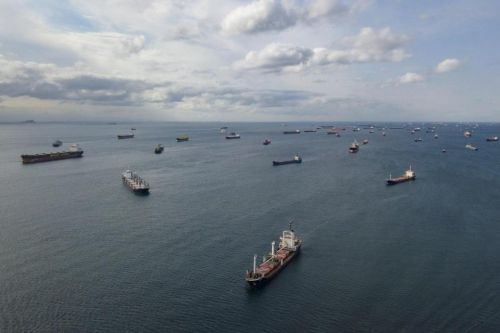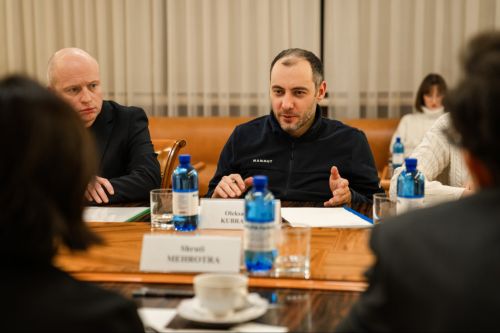On 19 December, the Ministry for Development of Communities, Territories, and Infrastructure announced that 302 vessels had exported 10 million tons of cargo through Ukraine’s temporary maritime corridor in the Black Sea since the launch of the corridor in August 2023. In addition, the ministry said that the ports of Greater Odesa had received 337 new ships for loading since the launch of the corridor and that the ports were preparing to receive an additional 79 ships. The corridor is used by several dozen companies, although some major shipowners are still wary of using it. In addition to agricultural products, mining and metal products and other goods are transported through the corridor. Some ships also deliver imported goods through the corridor.
Without exaggeration, this can be called the key success in the transportation industry in the outgoing year. For this, we should thank the Armed Forces of Ukraine, the Military Intelligence Service, the leadership of the Ministry of Development of Communities, Territories, and Infrastructure, and Ukrainian diplomats who did the “homework” necessary to make the new corridor work.
In a maritime grip
A Russian blockade of Ukrainian seaports preceded the full-scale Russian invasion of Ukraine in February 2022. Russia took this step deliberately, having realized that seaports are the main gateway for Ukrainian exports.
Therefore, the launch of the Black Sea Grain Initiative in July 2022 with the participation of Russia, the United Nations, and Turkey, which established a humanitarian maritime corridor to allow ships to export grain and other foodstuffs from Ukraine, was a justified step at the time to at least partially unblock Ukrainian maritime exports. This corridor was the main channel for agricultural exports from Ukraine in the fiscal year 2022/23.
However, within four months of the Black Sea Grain Initiative coming into force, Russia began sabotaging it by artificially creating long queues of ships. On 26 June 2023, Russia’s representatives at the Joint Coordination Center of the Black Sea Grain Initiative in Istanbul completely stopped the registration of new ships for entry into Ukrainian ports. The Black Sea Grain Initiative expired on 17 July, but Russia refused to extend it and thus guarantee the safety of shipping.
Ukrainian farmers exported 32.8 million tons of grains and oilseeds by sea during the period of implementation of the agreement. According to the United Nations, 1,002 vessels used the corridor to transport agricultural products to Africa, Asia, and Europe from the beginning of August 2022. According to a report by the Kernel company, the corridor accounted for 54% of Ukraine's total grain exports, 27% of its total vegetable oil exports, and 38% of its oilseed meal exports during the season.
After withdrawing from the Black Sea Grain Initiative, Russia attempted to discourage ships from loading cargo at Ukrainian ports by launching a series of attacks on Ukrainian port infrastructure. For example, it attacked the port of Chornomorsk on 19 July, the port of Odesa and the port of Reni a few days later, and the port of Izmail on 4 and 16 August. It was later estimated that the attacks on Ukrainian seaports damaged 167 port infrastructure facilities and 7 civilian vessels and destroyed about 300,000 tons of grain.
Russia only understands force
However, the successes of the Ukrainian military in the Black Sea have helped to limit the capabilities of the Russian naval fleet.
According to the Monitoring Group at the Institute of Black Sea Strategic Studies, the largest number of attacks on facilities in the occupied Crimean Peninsula and ships of the Russian Black Sea Fleet took place this summer. There were 18 attacks in June, 21 in July, and 30 in August. A milestone was the attack by a Ukrainian maritime drone on the Russian naval base in the port of Novorossiysk, hitting the large landing ship Olenegorsky Gornyak. This once again demonstrated the vulnerability of the Russian naval fleet. After that, Ukraine issued a coastal warning, declaring Russia’s Black Sea ports under military threat.
In total, the Ukrainian military has destroyed 15 enemy vessels and damaged 12 since the start of the full-scale invasion. As Ukrainian Navy spokesman Dmytro Pletenchuk later noted, the enemy is having "a kind of rethink" focused on preserving its naval fleet by moving it out of harm's way.
The Military Intelligence Service also entered the fray. At least from what has been made public, Military Intelligence special forces raided the "Boyko Towers" to dismantle Russian intelligence equipment, making it possible to tighten Ukraine's control over the Black Sea.
"We were able to resume shipping to and from Ukrainian ports thanks to the military successes, the successes we had in the Black Sea - pushing back the Russian navy - and other measures that are very sensitive in terms of security measures," said Ukraine's Deputy Economy Minister Taras Kachka.
The Ukrainian government, represented by the leadership of the Ministry of Development of Communities, Territories, and Infrastructure, also considered the possibility of reopening the Black Sea maritime corridor under new conditions - without "security" guarantees from Russia and, indeed, without international agreements involving Russia but within the framework of Ukrainian legislation and in accordance with international law. In June, the Ukrainian Cabinet of Ministers introduced a new procedure for guaranteeing compensation to shipowners for damage caused by Russia's armed aggression against ships in Ukraine's territorial waters (12 miles). The procedure provides for payment of compensation in case of destruction or damage to a vessel, loss or damage to cargo, injury, or death of crew members. It is a state guarantee: if a shipowner's insurance company refuses to pay an insurance claim, Ukraine guarantees compensation. Although there are still questions about the size of the insurance fund, shipowners have apparently welcomed the government's intention.
The interim result
As early as October, the Ukrainian grain corridor demonstrated its ability to accommodate eight inbound and outbound vessels per day. This was the same number of vessels that passed through the grain corridor established under the Black Sea Grain Initiative per day. Capesize bulk carriers have resumed calling at the ports of Greater Odesa, particularly the Port of Pivdennyi, indicating an increase in the volume of ore exports by sea.
"In the four months since the corridor has been in operation, the range of cargoes has been expanded and their export has begun. The volume of agricultural products has increased significantly: from 278,000 tons in the first month to almost 5 million tons now," the ministry said.
According to the Ukrainian Ministry of Agrarian Policy and Food, the total export volume of grain and leguminous crops from Ukraine in the 2023/24 fiscal year amounted to almost 15.3 million tons as of 15 December. This is down 23% (4.7 million tons) compared with the previous season. The total export volumes in the fiscal year will largely depend on the situation in the Black Sea.
Although export volumes are lower than last year, Deputy Prime Minister of Development of Communities, Territories, and Infrastructure and Minister of Infrastructure Oleksandr Kubrakov is optimistic that Ukraine will "make up for lost time." According to him, "shipping looks normal, as it was before the war."
According to Kubrakov, the agreement with London-based Lloyd's and broker Marsh McLennan has already cut insurance costs in half. The government has said that it is continuing to work to reduce insurance costs.
Yurii Skichko, co-owner of the Agrovista holding company and director of the Hermes Trading company, considers both the launch of the grain corridor and its reboot at the beginning of this fiscal year "fundamental steps to protect the country from the possibility of thousands of farmers going bankrupt." "Ukraine has significantly increased exports by reducing logistics costs by USD 30-40 per ton and increasing the export capacity of the terminals in the ports of Greater Odesa. As a result, producers have reached price levels that make growing crops profitable and lay the groundwork for future harvests," he said in comments to the CFTS portal.
According to him, the reopening of the grain corridor to the seaports is especially important given this year's good harvest. "The Danube's logistical infrastructure could no longer handle the load; in addition, Ukraine's land borders with neighboring countries were closed to the import and even transit of agricultural products from Ukraine," he said.
As noted above, the maritime corridor is used not only by farmers. Exports of mining and metallurgical products are second in terms of volume. In November, 14 vessels exported a total of about 620,000 tons of iron ore and 140,000 tons of steel products from two Ukrainian seaports and in October, exports of Ukrainian iron ore through the ports of Greater Odesa totaled approximately 507,000 tons.
According to data from the Ukrainian Railways joint-stock company (Ukrzaliznytsia), Ukrainian steelmakers are also increasing their exports. The volume of shipments to seaports increased by 66% to 1.3 million tons in November, compared with October.
However, the term "grain corridor" is used more often in the highest circles of the Ukrainian government because agricultural products from Ukraine are of great importance to the rest of the world, since exports of agricultural products help prevent a significant deterioration of the humanitarian situation in countries on the verge of famine. Exports of agricultural products also help to stabilize global food prices.
Businesses and the leadership of relevant Ukrainian agencies, including the Ukrainian Sea Ports Authority (USPA), are planning to further expand the range of cargo handled in the ports of Greater Odesa in 2024. Containers could be added. There is also cautious optimism about reopening the ports of Mykolaiv and Olvia. However, this requires the elimination of the threat to shipping in the Dnieper-Bug Estuary canal posed by Russian troops on the Kinburn Spit.
The "Mistress of the Seas" to the rescue
Ukraine and its partners are working to make the export corridor safer by eliminating the threat posed by the Russian naval, missile, and air forces, as well as through mine clearance. The continued success of Ukraine's maritime exports lies particularly in the military sphere. Apparently, the United Kingdom, which in the past held the proud title of the "Mistress of the Seas," will play "first fiddle" in this process.
In late November, Ukraine’s President Volodymyr Zelenskyi announced that additional air defense systems would protect the Odesa region. According to him, a request for these air defense systems has been submitted to Ukraine's international partners and has already been approved.
In addition, Romania, Bulgaria, and Turkey plan to sign an agreement on joint mine clearance in the Black Sea in January 2024. If the agreement is approved, their mine-clearance task force will not be considered a NATO operation, but the first major joint action by the Black Sea allies since the start of the full-scale war in Ukraine.
Meanwhile, Britain will transfer two of its minehunter ships to Ukraine. “These minehunters will deliver vital capability to Ukraine which will help save lives at sea and open up vital export routes, which have been severely limited since Putin launched his illegal full-scale invasion,” British Defense Secretary Grant Shapps said. It has also been reported that 23 speedboats and 20 Bandvagn BvS 10 (Viking) two-link tracked all-terrain vehicles will be transferred to Ukraine to protect its coastal areas.
Britain, along with Norway, will lead a new Maritime Capability Coalition to strengthen the capabilities of the Ukrainian Navy. The new coalition will build the support that Britain, Norway, and others are providing to Ukraine. This will be long-term support to help Ukraine transform its navy, making it more compatible with Western allies, more interoperable with NATO, and bolstering security in the Black Sea. Members of the coalition will provide Ukraine with ships, equipment, and training for naval and river flotillas, marines, air defense, mine countermeasures, and more.
"The sea is a big waterway, and it should be equal for everyone. So, we need to protect it and become such a powerful fleet that Russia will never have the desire to seize it again," said Ukrainian Navy Commander Oleksii Neizhpapa, commenting on the creation of the coalition.





